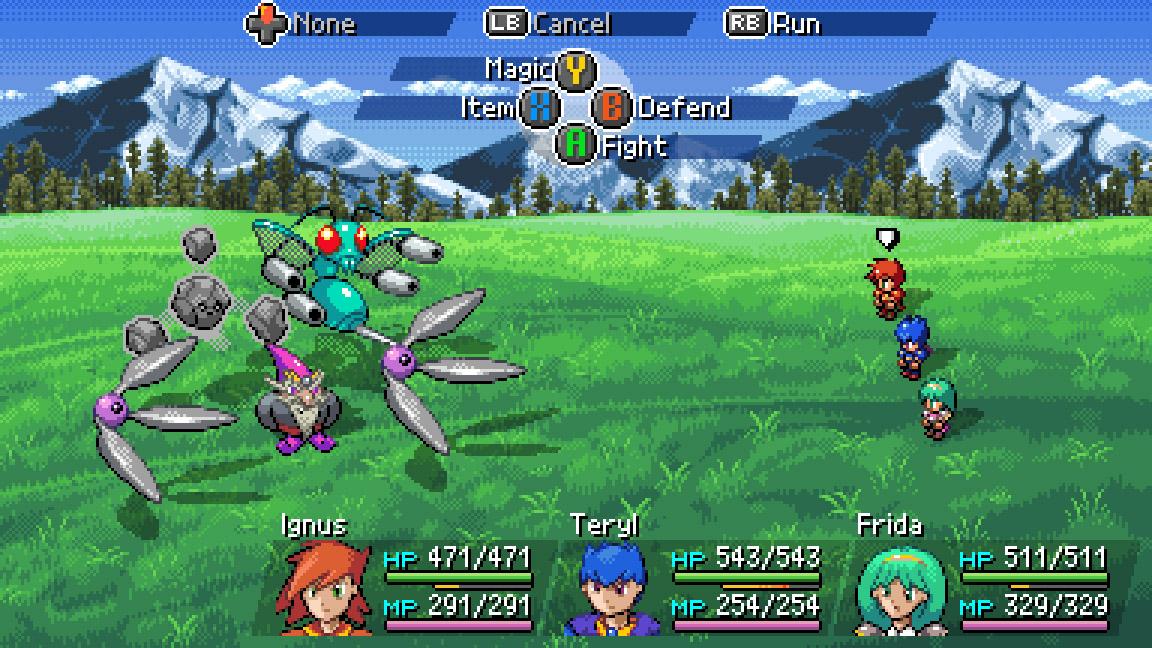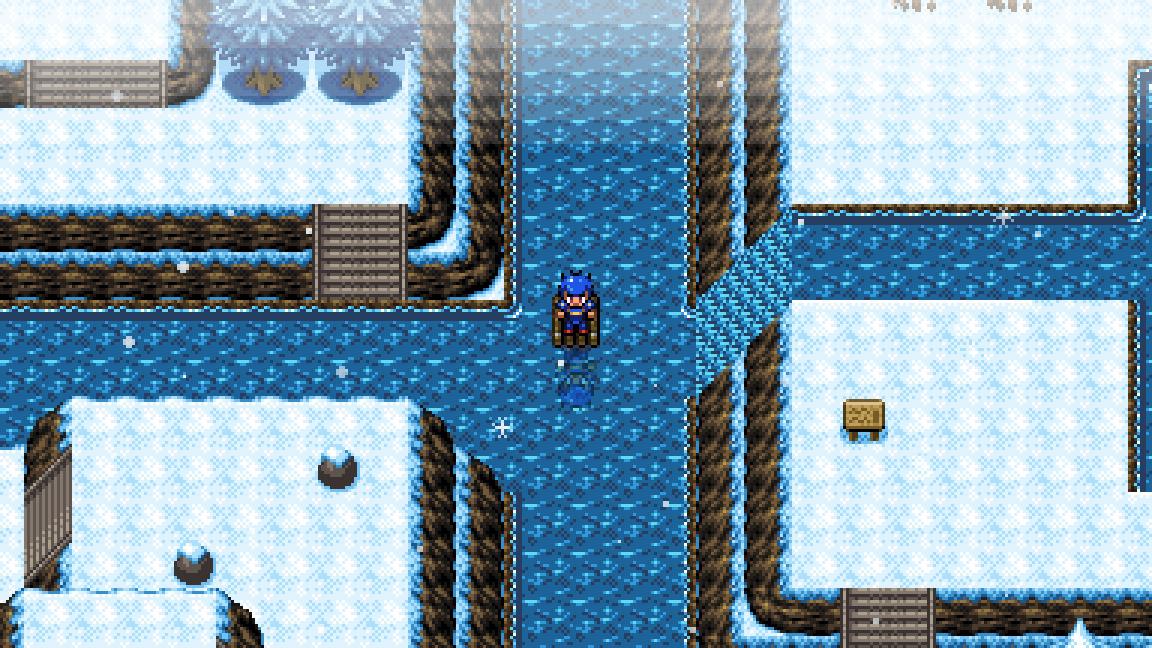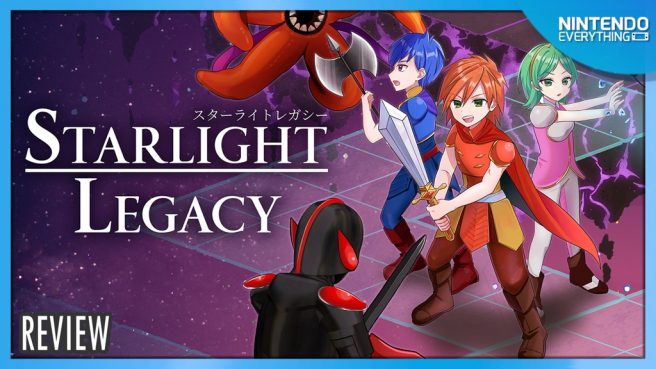System: Switch
Release date: May 28, 2025
Developer: Eastasiasoft / Decafesoft
Publisher: Eastasiasoft
The Nintendo Switch is the ultimate RPG console. Over the last eight years, the console’s RPG library has grown from humble beginnings to play host to countless modern, classic, and retro-inspired indie titles. Some are juggernauts, others are useless schlop, and a select few fly under the radar as true hidden gems. As Nintendo Switch’s lifecycle winds to a close, this steady stream of RPGs marches on – now with nonlinear 16-bit adventure Starlight Legacy.
Let’s get that glaring weakness out of the way first. Even for a budget RPG, the storytelling in Starlight Legacy leaves a lot to be desired. The game’s three protagonists don’t offer much in the way of depth, and the majority of the dialog reads like a 8- or 16-bit era game with a truncated script. That being said, the ingredients for a great story are all there.
Rebellion simmers within the Kingdom of Evaria. Two generations ago, the continent’s four provinces were conquered and united under a single crown, with the Sky Province in particular offering stiff resistance. In the aftermath, Sky Province citizens were forbidden from studying magic, a situation that fuels the rebellion in the modern day. Central to the modern conflict is King Lennox, Evaria’s ruling monarch. While somewhat bumbling at the start, the King proves fiercely resistant to any reform, which only provokes the rebel leadership to increasingly extreme measures.
The framework is here for a compelling tale, one which analyzes the harsh realities of oppression, political violence, and the citizens on both sides of the conflict who suffer as a result. Unfortunately the story never fully commits to meeting its themes head on, taking a more simplistic and at times cartoonish approach instead.

Story aside, the game’s core gameplay systems all work together well. Combat follows a standard turn-based template, pitting a party of three heroes against hordes of fiercesome monsters. You won’t find any major surprises here – HP, MP, attacks, spells, status effects, and a sprinkling of special abilities to keep things interesting. Easily the two best abilities you’ll find are the “Spin” ability, which functions as free attack to hit all enemies, and the “Summon” ability, which allows you to summon any monsters you’ve defeated to attack your enemies, bosses included.
Your main characters have a few superficial differences, but share the majority of ability options and can be trained to use every spell in the game. Most abilities can be learned by any character, with only a handful that – rather than being exclusive to a single character – are simply left OFF the ability list of one. That leaves pretty much the entirety of character customization down to the player’s choices. You can equip any character with any piece of equipment, and the game allows you to double-up on weapons and defensive items. Want to equip two shields? Go for it. Want to duel weal wizard staffs for extra magic power? Blast away. You can even use consumable items to change each character’s elemental affinity – the customization can be robust, even amongst its limitations.
As you traverse the game’s interconnected world map, the monsters will scale to your story progression, always offering a consistent challenge. At a few points, you may find the difficulty spiking, as the game does not hold back on making tricky encounters packed with powerful attacks and status effects. In these cases, a bit of grinding might be in order. Thankfully, the options menu offers the chance to both turn monster encounters on and off and to double your experience gains. I used these quality of life features with abandon, cranking up experience to grind and then turning off encounters so I could freely explore the game’s impressive world map/

Map design is the true highlight of Starlight Legacy. The game bills itself as a non-linear adventure, and it delivers on that promise in a tightly designed, modular package. Travel between the individual regions of Evaria is tightly controlled by the King, requiring a key item called a Bridge Pass to permit travel to each. As you progress through the story, you will acquire additional Bridge Passes, each of which can be used to access any region of your choice. Will you head to the snowy mountain region, filled with powerful ice-type monsters first, or head off into the desert where fire-breathing crustaceans wait to test your mettle? The choice is yours.
This basic structure reveals additional layers of complexity as the game progresses. Three of the four regions are themed around a specific element, offering elemental-themed rewards for your progress. You could, hypothetically, travel through the regions in a Mega Man-esque sequence, leveraging the spells, equipment, and summonable monsters from one region to gain an advantage in the next.
Each region also comes with a Pokemon-inspired traversal ability that gives you access to hidden items and shortcuts as you explore. Many of these item boxes will come with a number on the lid, indicating how many regions you need to have cleared to open it. These typically come with powerful spells and equipment, giving you both an incentive to backtrack and a means of gaining leveled rewards as you progress. Every region will include roadblocks associated with all four areas, meaning there’s always something left to be explored further down the line.

In fact, this Pokemon inspiration is evident throughout the game. Aside from the traversal abilities, each map comes complete with little hoppable ledges that help form additional shortcuts and hidden secrets. The spritework itself harkens back to games like Pokemon Ruby and Sapphire, and the in-game map visually borrows from early games in the series as well. It’s all lovingly done and the maps themselves are well designed, making this less of a lazy imitation and more of a loving homage.
That is, at the end of the day, what everyone should look for in a budget RPG like this. A thirteen-dollar game is allowed to be simple, so long as that simplicity is well executed. Starlight Legacy easily meets that standard.

As far as retro-inspired RPGs go, you can’t go wrong picking up Starlight Legacy. While the storytelling and dialogue certainly won’t be winning any awards, the core gameplay systems – and particularly the map design – more than make up for the game’s shortcomings. While difficulty spikes may hit as you as you transition between regions, the game’s quality of life features and the generous rewards tucked away around the map more than make up for it. This is a budget RPG done right, and well worth the short run time.
Starlight Legacy copy provided by the publisher for the purposes of this review.
